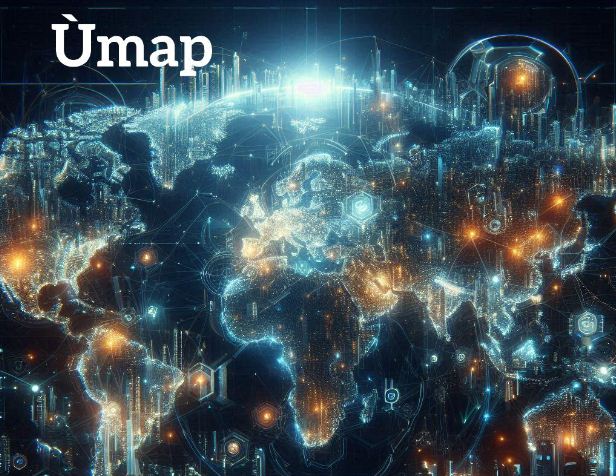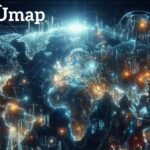Imagine a platform where you can customise your own map tailored to your exact needs. Ùmap offers an ultimate solution that unrolls paper maps with its advanced technology. On behalf of Neybg, I have thoroughly analysed this cutting-edge digital mapping solution.
This article sheds light on the detailed technological evaluation behind this digital mapping, its different types, applications in various industries, and pros and cons. So, let’s dive into the journey towards this innovative technological solution with us.
Real Essence of Ùmap
The digital map Ùmap serves as a guide in the vast ocean of data complexity. It is an acronym for Uniform Manifold Approximation and Projection. The introduction of this digital mapping solution has completely changed the game. It has made the navigation and access of geographical information super easy.
It offers several benefits over conventional maps. This tool delivers real-time updates, interactive elements, and even dynamic components to enhance accessibility and spatial awareness. It has reshaped how we navigate and enhance the feasibility of data analysis and decision-making. Logistic optimisation, urban planning, and the catastrophe industry rely highly on these digital mapping technologies.
Technological Evaluation of Digital Map
As I have examined the core technologies of Ùmap, I have found that two core technologies, Virtual Reality (VR) and Augmented Reality (AR), are delivering immersive experiences. These technologies allow users to access interactive web maps and make their own unique perspective.
The use of trending technologies in this Ùmap’s digital mapping solution delivers distinct characteristics that meet the demands of different industries. It analyses the patterns of data and responds according to that. From its launch to its current state, it has been supporting users by evaluating its technological structure to share data and work together in real time.
Types of Ùmap
The types of Ùmap have been separated based on their different technological incorporation. I have analysed each type to deliver you a detailed insight:
Virtual And Augmented Reality Maps
Virtual And Augmented Reality Maps have entirely transformed how people use and engage digital geographical data. This digital mapping type allows users to experience an outstanding 3D world without even stepping out of their homes or desks. We can now imagine city shapes, interiors, and landscapes with detailed insights because of this technology.
Geographic Information Systems (GIS)
The Geographic Information Systems (GIS) now offers a whole new way to work on geographical data. This type of mapping system allows users to generate personalised maps according to their unique needs. It allows us to examine data correlations, patterns, and trends that might not be visible in conventional maps. It Ùmap acts as a powerful tool to make more effective decisions based on location-based data.
Interactive Web Maps Ùmap
Interactive Web Maps play a significant role in enhancing the ability to study and traverse geographical data. Users can now easily layer data by making, editing, and sharing maps online. With a simple click of a button, the Interactive Web Maps Ùmap can allow access to environmental elements and demographic information.
Application in Diverse Field
The application of digital mapping technology has reshaped diverse industries all across the world. Here I have analysed a few applications of this map in diverse fields:
Healthcare
The healthcare industry applies Ùmap’s advanced technology to monitor disease outbreaks in specific areas. The use of this mapping can also help in optimising and responding quickly in times of emergency.
Real
Retail stores use this technology to understand the behaviour and preferences of specific location’s customers. It also helps stores to find the best spot to attract customers.
Agriculture
The application of Ùmap in agriculture is significant. This technology helps farmers to do precision farming. This mapping technology helps farmers improve crop yields by allocating resources and analysing soils more efficiently. The real-time data from the digital map helps with disaster management tasks and organise rescue management.
Pros and Cons of Ùmap
Here are some pros and cons of digital mapping that can help you make better use of this technological tool:
Pros of Ùmap
- Allows you to monitor data and make personalised maps for exceptional clarity and better decision-making.
- It acts as a potent instrument for data visualisation, geographical analysis, and navigation.
- One of its core advantages is the real-time updates and dynamic information.
- Ùmap allows users to track traffic patterns in specific areas, evaluate market trends, and monitor environmental changes.
- You can share and alter maps which also enhances the collaborative capabilities. People from diverse fields may now collaborate to improve efficiency and communication.
Cons of Ùmap
- The complicated technology of GIS software and VR can be a typical problem for many non-tech users.
- There is always a possibility of inaccurate mapping data that can result in incorrect information.
- There are a few ethical aspects that Ùmap needs to consider to make this solution more secure and safe.
Future of Digital Mapping
As we sneak into the future of Ùmap, there are numerous ground-breaking possibilities in this mapping technology. The tool can improve its 3D mapping with more advanced technology to receive real-time updates and give users the most up-to-date information. The incorporation of IoT devices opened new opportunities for smart cities and effective resource management.
The digital mapping always has the potential to further extend its capability. By improving the geospatial visualisation tools, this tool can also enhance the decision-making process in various fields like catastrophe management and urban planning. We can expect that the final product will deliver a more dynamic and engaging experience for the users.
Conclusion
It can be concluded from the above analysis that the Ùmap opens a big opportunity for diverse fields. It has completely changed the way people used to optimise and analyse spatial data. Though there are a few challenges and limitations in the application of these digital maps, we can expect continuous improvement through the adaption of VR and GIS technology can improve its operation.
We hope you have enjoyed the journey of digital mapping. To experience more fascinating technological innovations, keep an eye on Neybg. Till then, enjoy your exploration with Ùmap’s innovative offerings and stay ahead of the technology trend.
FAQs:
What is Ùmap?
Ùmap is an advanced mapping technology that has transformed static paper mapping into digital mapping. It allows users to analyse and optimise real-time data and customise their own map.
What are the technological evaluation in Ùmap?
The digital map uses emerging technologies such as GIS, VR, AR, and Interactive Web to personalise maps, make better decisions across different sectors, and analyse market trends.
Which industries get benefits from Ùmap?
Industries like healthcare, retail, and agriculture get huge benefits from the incorporation of digital mapping.
Are there any risks associated with the use of Ùmap?
There are risks of data security, ethical usage, incorrect information, and technological disruption associated with the usage of Ùmap.
What is the future of digital mapping?
Digital mapping reflects a bright future as it has the potential to improve data visualisation and resource management by developing its features with advanced technologies like the Internet of Things (IoT), machine learning, and artificial intelligence.


